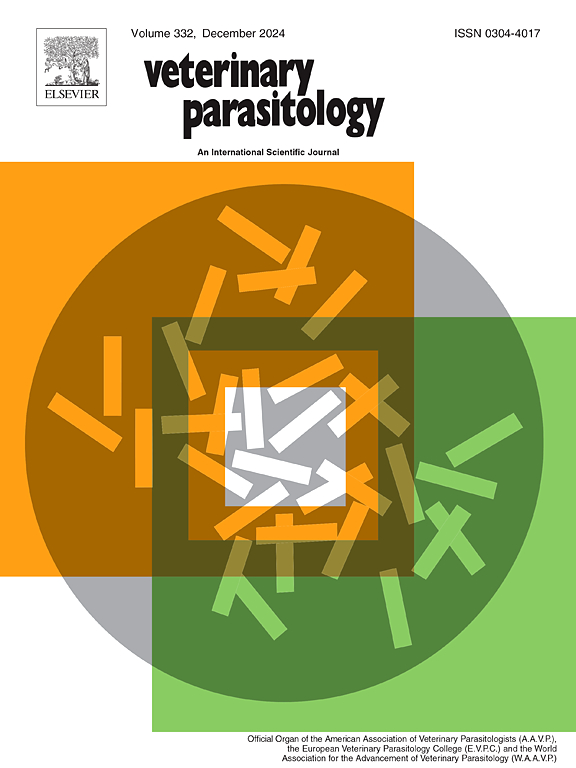用于检测狗体内幼年利什曼病抗体的四种商用血清学试验的比较
IF 2
2区 农林科学
Q2 PARASITOLOGY
引用次数: 0
摘要
早期发现和治疗婴儿利什曼原虫感染病例对于控制该病在犬类中的传播至关重要。几种血清学方法可用于支持犬利什曼病的诊断。免疫荧光抗体试验(IFAT)和酶联免疫吸附试验(ELISA)是临床医生使用的主要检测方法。高抗体水平与严重的寄生虫病和疾病有关,是临床利什曼病的诊断。相反,低抗体水平的存在并不一定表明疾病,可能更难以通过血清学试验检测出来。本研究的目的是评估和比较四种市售血清学检测的诊断性能,包括ELISA (CIVTEST®CANIS利什曼原虫短协议和标准协议)、利什曼原虫-ELISA DOG®、ELISA/S7®和MegaFLUO®LEISH IFAT,用于检测不同感染状态下狗体内针对婴儿L.抗原的特异性抗体。以室内UAB酶联免疫吸附试验(ELISA)为参考,将血清阳性感染犬( = 75)、血清阳性表面健康犬( = 48)、血清阴性表面健康犬(加的斯,n = 40)和血清阴性表面健康犬(阿斯图里亚斯,n = 40)的犬血清进行分类。积极的百分比协议(PPA)和消极的百分比(NPA)的协议为每个测试如下:CIVTEST®标准(93.4 %、100 %)对202个样本测试,CIVTEST®短(84.4 %、100 %)对202个样本测试,LEISHMANIA-ELISA狗®(81.8 %,72.2 %)对138个样本测试,ELISA / S7®(45 34.8 %,%)对195个样本测试和MegaFLUO®LEISH IFAT(100 %、100 %)对203个样本测试,分别。准确率分别为:CIVTEST®标准(0.96)、CIVTEST®短(0.91)、LEISHMANIA-ELISA DOG®(0.77)、ELISA/S7®(0.39)、MegaFLUO®LEISH IFAT(1)。Cohen ' s Kappa指数(K)由好到坏依次为:MegaFLUO®LEISH IFAT (K= 1)、CIVTEST®标准(K= 0.92)、CIVTEST®短(K=0.81)、LEISHMANIA-ELISA DOG®(K= 0.54)、ELISA/S7®(K=-0.19)。最后,在elisa试验中,受试者工作特征曲线下面积(AUC-ROC)从最大值到最小值依次为:CIVTEST®short(1)、CIVTEST®standard(0.99)、LEISHMANIA-ELISA DOG®(0.87)、S7®(0.37)。总之,本研究表明,市售的ELISA检测对婴儿乳杆菌抗原的诊断性能差异很大。此外,它强调了一个事实,即CIVTEST®犬利什曼是一个可靠的测试,以支持临床诊断犬利什曼病。本文章由计算机程序翻译,如有差异,请以英文原文为准。
Comparison of four commercial serological tests for the detection of Leishmania infantum antibodies in dogs
Early detection and treatment of cases of Leishmania infantum infection are critical in controlling the spread of the disease in dogs. Several serological methods are available to support the diagnosis of canine leishmaniosis. The immunofluorescence antibody test (IFAT) and enzyme-linked immunosorbent assay (ELISA) are the main tests used by clinicians. High antibody levels are associated with severe parasitism and disease and are diagnostic of clinical leishmaniosis. Conversely, the presence of low antibody levels is not necessarily indicative of disease and may be more difficult to detect by serological tests. The aim of this study was to evaluate and compare the diagnostic performance of four commercially available serological tests, including ELISAs (CIVTEST® CANIS LEISHMANIA short and standard protocols), LEISHMANIA-ELISA DOG®, ELISA/S7® and MegaFLUO®LEISH IFAT, for the detection of specific antibodies against L. infantum antigens in dogs in different states of infection. Canine sera samples from seropositive sick infected dogs (n = 75), seropositive apparently healthy dogs (n = 48), and seronegative apparently healthy dogs from a high endemic area (Cadiz, n = 40) and seronegative apparently healthy dogs from very low endemic area of L. infantum infection (Asturias, n = 40) were classified based on the results of an in-house UAB ELISA as a reference test. The positive percent of agreement (PPA) and negative percent of agreement (NPA) observed for each test were as follows: CIVTEST® standard (93.4 %, 100 %) on 202 samples tested, CIVTEST® short (84.4 %, 100 %) on 202 samples tested, LEISHMANIA-ELISA DOG® (81.8 %, 72.2 %) on 138 samples tested, ELISA/S7® (34.8 %, 45 %) on 195 samples tested and MegaFLUO®LEISH IFAT (100 %, 100 %) on 203 samples tested, respectively. The accuracy was as follows: CIVTEST® standard (0.96), CIVTEST® short (0.91), LEISHMANIA-ELISA DOG® (0.77), ELISA/S7® (0.39), and MegaFLUO®LEISH IFAT (1). The Cohen´s Kappa index (K) from best to worst was: MegaFLUO®LEISH IFAT (K = 1), CIVTEST® standard (K = 0.92), CIVTEST® short (K=0.81), LEISHMANIA-ELISA DOG® (K =0.54), and ELISA/S7® (K=-0.19). Finally, the area under the receiver operating characteristic curve (AUC-ROC), in the ELISAs test, ordered from the maximum to the minimum value was: CIVTEST® short (1), CIVTEST® standard (0.99), LEISHMANIA-ELISA DOG® (0.87), and S7® (0.37). In conclusion, this study demonstrated that the diagnostic performance of the commercially available ELISA tests against L. infantum antigen can vary widely. Moreover, it highlights the fact that CIVTEST® CANIS LEISHMANIA is a reliable test to support the diagnosis of canine leishmaniosis in clinical settings.
求助全文
通过发布文献求助,成功后即可免费获取论文全文。
去求助
来源期刊

Veterinary parasitology
农林科学-寄生虫学
CiteScore
5.30
自引率
7.70%
发文量
126
审稿时长
36 days
期刊介绍:
The journal Veterinary Parasitology has an open access mirror journal,Veterinary Parasitology: X, sharing the same aims and scope, editorial team, submission system and rigorous peer review.
This journal is concerned with those aspects of helminthology, protozoology and entomology which are of interest to animal health investigators, veterinary practitioners and others with a special interest in parasitology. Papers of the highest quality dealing with all aspects of disease prevention, pathology, treatment, epidemiology, and control of parasites in all domesticated animals, fall within the scope of the journal. Papers of geographically limited (local) interest which are not of interest to an international audience will not be accepted. Authors who submit papers based on local data will need to indicate why their paper is relevant to a broader readership.
Parasitological studies on laboratory animals fall within the scope of the journal only if they provide a reasonably close model of a disease of domestic animals. Additionally the journal will consider papers relating to wildlife species where they may act as disease reservoirs to domestic animals, or as a zoonotic reservoir. Case studies considered to be unique or of specific interest to the journal, will also be considered on occasions at the Editors'' discretion. Papers dealing exclusively with the taxonomy of parasites do not fall within the scope of the journal.
 求助内容:
求助内容: 应助结果提醒方式:
应助结果提醒方式:


